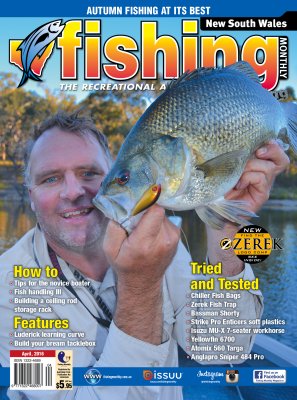Build a great bream tacklebox! by Jamie Robley
 Lure casting for bream sits right at the top of the Aussie-angling list. This branch of the sport has grown from humble and experimental beginnings four decades ago into a multimillion-dollar growing industry.
Lure casting for bream sits right at the top of the Aussie-angling list. This branch of the sport has grown from humble and experimental beginnings four decades ago into a multimillion-dollar growing industry.
Consequently, the volume of bream lures available to us seems limitless, with newer and advanced types constantly hitting the market. They range from intricately crafted works of art through to bizarre oddities that you'd think would scare the fish away! Some come and go, while others go on to become classics that earn a reputation of excellence among serious bream anglers.
With such an enormous array of lures on the market, does it make sense to own as many as possible? Aside from verging on the impossible and draining the bank balance, it's probably not practical to spend a lot of time and money buying up and then giving each lure a run to see how it goes.
That's where feedback from different anglers helps determine which types do well and are worth a try. Angling publications, websites, forums, TV shows and DVDs all spread knowledge and it doesn't take long before a hot performer becomes well known. Of course, some lures that are probably very good can easily fly under the radar and fade into obscurity, while others end up more popular due to hype and marketing over real world performance.
Perhaps the best approach to buying lures with the aim of using them on bream is to partly take in the gospel from fishing media and big name tournament anglers and do the rest purely by experimentation, seeing what works for you on your home turf. Even around my local waterways on the Central Coast, some lures will work fantastically in one spot and be almost useless at another spot. Time on the water, and trying different techniques is the only way to see what's hot or not.
LURE CATERGORIES
During the late 1980s this style of fishing was starting to become more popular largely due to smaller hardbody lures arriving on our shores. I still remember Steve and Tim Morgan enthusiastically casting the new translucent Rebel Crawfish around Brunswick Heads during that period, which is a classic example of the type of lure that heralded the bream angling boom.
Small hardbody lures, with a bib that makes them dive and swim with a wobbling action soon became the standard bream lure around the country. Most of the early favourites were American types, but a few local manufacturers came up with some excellent lures as well.
As the style of fishing advanced, it became quite obvious that bream also hit lures on the surface, particularly through the warmer months. While any of those diving hardbodies could effectively catch bream by leaving them sitting motionless on the surface, small bass style poppers and even flies tied to resemble insects proved more successful and so surface lure breaming was born.
Eventually a new type of lure changed everything. Soft plastics, often referred to as 'squidgies' by a couple of South Coast bream anglers, made an entrance into the market. The softy boom ended up taking anglers by storm, and within the space of a few years hardbody luring for bream had faded substantially. Perhaps the biggest hit among these newer softies was Berkley's 3" Powerbait Minnow, in the incredibly effective pearl/watermelon colour.
Things keep evolving and despite the popularity of soft plastics, the earlier style hardbodies have had resurgence, this time with a distinctly Japanese flavour. Around 2007 anglers started to use little metal lures, commonly called blades or vibs. This form of lure ended up being one of the deadliest of all.
Now the bream luring world is filled with all forms of lure, soft, hard, deep, surface and everything in between. Each type has a time and place when it will probably outfish the rest of the pack. Overall it's a good idea to have at least a few different styles, sizes and colours in the kit.